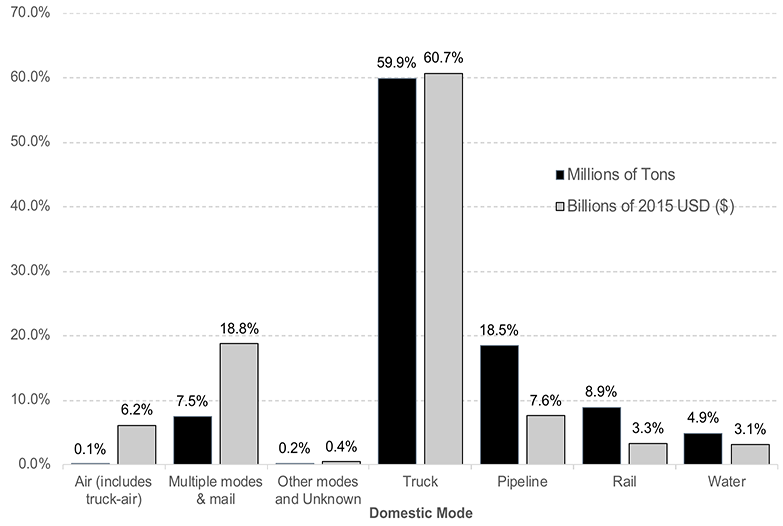Status of the Nation's Highways, Bridges, and Transit Conditions and Performance: 23rd Edition: Part III: Highway Freight Transportation - Report to Congress
Executive Summary
Chapter 11: Freight Transportation
Freight transportation is vital to the U.S. economy and the daily needs of Americans throughout the country. Households and businesses depend on the efficient and reliable delivery of freight to both urban and rural areas. Federal support for freight increased under the Fixing America's Surface Transportation (FAST) Act, as the FAST Act included provisions to define, establish, and provide funding for a national highway freight program. The FAST Act freight provisions were designed to address significant needs in the transportation system to ensure that projected increases in freight volumes can be handled efficiently across all transportation modes.
In 2015, the transportation system handled a record amount of freight—including a daily average of approximately 55 million tons of freight, worth approximately $49.5 billion. The freight transportation industry employed 4.6 million workers and contributed 9.5 percent of the Nation's economic activity as measured by gross domestic product (GDP).
Although freight moves on all modes of transportation, trucks are involved in the movement of most goods. The highway system is the most-used mode of transport for freight by tonnage and value of goods moved. Commodities moved by truck have a higher value per weight, which gives trucking a higher share of freight dollar value.
Trucking accounted for nearly 30.5 percent of total transportation and warehousing sector employment. Truck driving is by far the largest freight transportation occupation, with approximately 2.83 million truck drivers. About 57.5 percent of these professional truck drivers operate heavy trucks and 28.2 percent drive light trucks.
As freight movements increase, the number of available safe truck parking spaces diminishes and is a growing concern.
Mode Share by Tonnage and Value, 2015

Note: USD=U.S. dollars
Source: Bureau of Transportation Statistics and FHWA, Freight Analysis Framework, version 4.2, 2016.
Truck Parking
Truck drivers need safe, secure, and accessible truck parking. With the projected growth in truck traffic, demand for truck parking will continue to outpace supply. In 2014, FHWA worked with States and industry partners on the Jason's Law Truck Parking Survey Results and Comparative Analysis to assess these needs. The resulting information quantified the commercial motor vehicle parking shortage at facilities along the National Highway System. The survey provided direct insight into parking issues: more than 75 percent of truck drivers surveyed said they regularly experienced problems finding "safe parking locations when rest was needed."